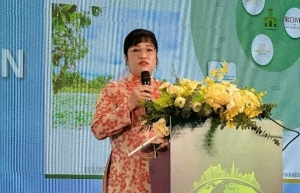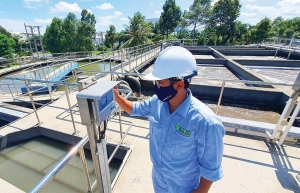Green developers seek preferential policies
Nguyen Duc Vinh, deputy head of the Housing and Real Estate Market Management under the Ministry of Construction (MoC), said that businesses face significant challenges in green real estate development.
“This starts with the customs and habits of businesses that operate projects in traditional ways, making it difficult to change old practices. While it is a communication issue, most of the community is aware of the net-zero goal, but the message has not yet spread widely,” Vinh said at Vietnam Green Building Week 2024, held in early October in Hanoi.
“Although Vietnam’s housing development strategy towards 2030 emphasises energy-saving housing development, this is not clearly expressed in specific goals. As a result, the application of standards on efficient energy use and environmental protection in the housing sector remains limited. Current energy-saving housing projects are initiated and implemented solely by investors,” Vinh added.
 |
| Green construction is costly, which hinders progress even if the long-term benefits are strong, photo Le Toan |
The second challenge is financial. Developing green real estate projects involves higher costs, so convincing businesses of the value of green, environmentally friendly solutions is a significant hurdle, he said. Vinh also pointed out that converting previously built real estate to the green trend is also a complex problem, not just developing new buildings.
“Additionally, the investment cost of green housing projects is often about 2 per cent higher than that of conventional housing. There is also a lack of promotion about the benefits of energy-efficient housing projects, which leads to limited interest from investors and customers buying or renting homes,” he added.
Le Thuy Ha, deputy head of Urban Development Policy and Strategy Research under the National Institute of Urban and Rural Planning, said that there was a lack of uniformity in urban development and limited awareness of green urban areas among enterprises and the public.
“Both businesses and individuals believe green construction is costly from the outset, despite the long-term benefits based on green criteria. This hesitance persists,” Ha said.
However, she noted that green urban planning has been unified at the national level, showing a harmonised connection from national down to grassroots levels, which supports economic development. This also provides a green foundation for urban planning.
“Green urban structures will be developed either in a concentrated form or combined with the construction of compact urban-style buildings and multipurpose complexes, increasing land use efficiency and reducing costs,” Ha said.
To implement green construction, Vinh at the MoC said the immediate priority is to focus on solutions that ensure quality living spaces and environmental benefits.
“First, we must research, promulgate, and supplement housing regulations and standards for new designs, techniques, and construction technologies aimed at improving housing quality, aligned with trends towards green, sustainable, and smart housing, applying digital technology,” Vinh explained.
He also highlighted the need to introduce preferential policies for organisations and individuals involved in developing green, energy-saving, and low-emission housing and applying digital technology.
“Furthermore, it is essential to promote the benefits of energy-efficient housing projects to attract more interest and support the development of this type of housing,” he added.
Vu Linh Quang, CEO of ARDOR Green, mentioned that there are numerous green standards investors can choose from.
“Each certification level has different requirements, which may slightly increase costs, but the value it brings to residents far outweighs the cost. Moreover, businesses can limit expenses through early-stage planning, applying technical solutions such as improved design and enhanced green spaces,” Quang said.
He also highlighted that EDGE standards are suitable for social housing, particularly in improving energy, water, and material efficiency.
Similarly, Luu Thi Thanh Mau, general director of Phuc Khang Investment and Construction, recommended that the MoC introduce a set of green building and project assessment tools specifically tailored for Vietnam.
“There should be a mandatory roadmap for implementing green building projects in Vietnam, alongside preferential policies like low-interest loans, floor area bonuses, and incentives for green bond issuers, as well as MoC awards to raise awareness of green buildings,” Mau said.
By the end of April, the number of green buildings nationwide had surpassed 400 projects, covering a total construction floor area of around 10 million sq.m, according to the MoC.
The World Economic Forum says that 80 per cent of buildings currently in operation will still be in use by 2050. Of these, the construction industry is responsible for up to 42 per cent of global CO2 emissions.
Meanwhile, real estate consultant Cushman & Wakefield estimates that by 2050 there will be 6.6 billion sq.m of commercial real estate across 143 countries. The cost of decarbonising the global real estate market is expected to be around $18 trillion.
 | Green high-rise buildings ensure healthy living space and environmental benefits Phuc Khang Corporation develops green high-rise buildings as part of its development strategy to ensure living space and environmental benefits. |
 | Industrial development must go green Companies are being urged to face up to the challenge of committing to sustainability while also offering up viable ventures. |
 | Green buildings in Vietnam: Harnessing potential and advantages According to a report by the Ministry of Construction, by the end of the third quarter of 2024, the number of green buildings in Vietnam had reached approximately 500, with a total floor area exceeding 12 million square metres. This achievement is the result of favourable government policies and active involvement from diverse stakeholders. |
What the stars mean:
★ Poor ★ ★ Promising ★★★ Good ★★★★ Very good ★★★★★ Exceptional
Related Contents
Latest News
More News
- Sun Group breaks ground on $2 billion Van Don casino complex (December 19, 2025 | 18:14)
- Rare, beautiful, sustainable: the mark of iconic real estate (December 19, 2025 | 08:00)
- Owner-occupied housing stabilises, paving the way for new growth cycle (December 18, 2025 | 17:04)
- Unlocking urban potential of smart cities (December 18, 2025 | 16:50)
- Green finance offers 'passport' for Vietnamese construction, building materials firms (December 15, 2025 | 08:00)
- Gamuda Land commit long-term investment (December 12, 2025 | 11:49)
- HITC ties up with Evolution to develop AI and hyperscale data centres in Vietnam (December 11, 2025 | 12:09)
- Real estate deals boom via high-profile names (December 08, 2025 | 11:32)
- Industrial segment shaped by M&As (December 08, 2025 | 08:00)
- The Privé sets the benchmark for luxury real estate (December 05, 2025 | 08:28)

 Tag:
Tag:




















 Mobile Version
Mobile Version